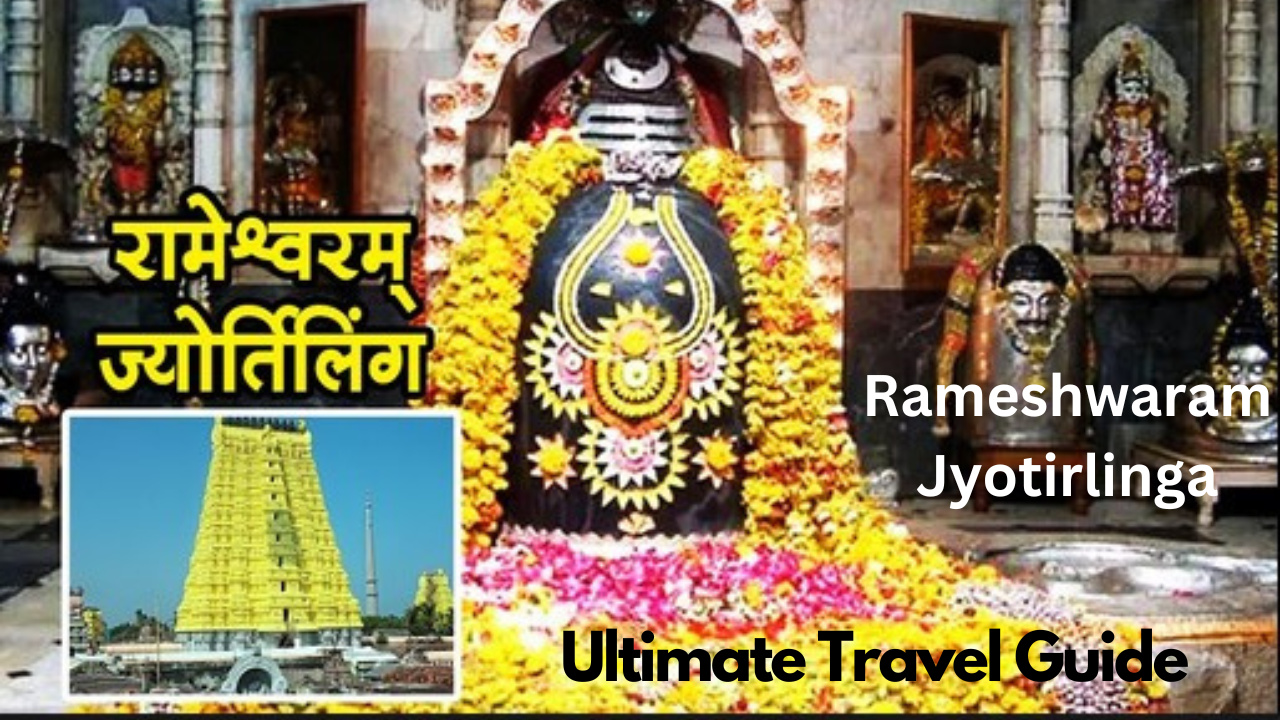Rameshwaram Jyotirlinga: The Southernmost Jyotirlinga of India

Introduction
Rameshwaram Jyotirlinga, located in Rameswaram Island, Tamil Nadu, holds the distinction of being the southernmost of the twelve Jyotirlingas in India. The temple showcases magnificent Dravidian architecture and is situated in a small town on Pamban Island. One of the remarkable features of the Rameshwaram temple is the presence of twenty-two water bodies within its complex.
Devotees believe in taking a holy bath in these water bodies before Darshan, as a mark of respect to Lord Shiva. The temple houses two Jyotirlingas, one sculpted by Lord Rama himself and the other brought from Kashi by Hanuman. It is believed that the Jyotirlinga brought by Hanuman is a replica of the Kashi Vishwanath Jyotirlinga.
With its rich history, beautiful architecture, adorned corridors, and thirty-six theerthams, Rameshwaram Jyotirlinga is not only a popular pilgrimage site but also considered the ‘Varanasi of the south.’
The Legend Behind Rameshwaram Jyotirlinga
According to the legend, there are two Jyotirlingas at Rameshwaram, one brought by Lord Hanuman and the other by Mother Sita. These Jyotirlingas are worshipped in the same order. Furthermore, Rameshwaram is the place where Lord Rama worshipped Lord Vishnu after his victory over Ravana.
Rameshwaram Temple Opening Hours
The Rameshwaram Temple welcomes devotees every day in two shifts. The temple opens from 5 AM to 1 PM and then again from 3 PM to 9 PM, allowing ample time for devotees to offer their prayers and seek blessings.
How to Reach Rameshwaram Temple
By Air Flights
The nearest airport to Rameshwaram Temple is the Madurai Airport, located approximately 177 km away. From the airport, visitors can hire a taxi or avail of other transportation options to reach the temple.
By Train
Rameswaram Railway Station is the nearest railway station to the temple, located just 1.5 km away. Upon arrival at the station, devotees can easily hire a taxi or opt for other local transportation to reach the temple.
By Road
Rameshwaram is well-connected by road, and various bus services operate from nearby cities and towns. Visitors can choose to travel by road and enjoy the scenic views during the journey.
Accommodation Options
When visiting Rameshwaram Jyotirlinga, there are various accommodation options available to suit different budgets and preferences. Here are some suggestions:
1. Hotels: Rameshwaram has numerous hotels ranging from budget to luxury. These hotels offer comfortable rooms, amenities like Wi-Fi, air conditioning, and often have in-house restaurants.
2. Guesthouses: Guesthouses provide a more homely atmosphere and are usually run by locals. They offer basic amenities and are a good option for those looking for a budget-friendly stay.
3. Ashrams: Rameshwaram is known for its spiritual significance, and there are ashrams where visitors can stay. These ashrams provide a tranquil environment and often offer simple accommodation and vegetarian meals.
4. Resorts: If you prefer a more luxurious stay, there are resorts in Rameshwaram that offer spacious rooms, beautiful views, and additional facilities such as swimming pools, spa services, and recreational activities.
5. Dharamshalas: Rameshwaram has several dharamshalas (charitable accommodations) that provide affordable or even free accommodation for pilgrims. These places usually offer basic facilities and are often managed by religious organizations.
It is advisable to book your accommodation in advance, especially during peak seasons and festival times, to ensure availability. Additionally, consider factors such as location, proximity to the temple, and the amenities you require while choosing your accommodation.
Rituals and Festivals

The Rameshwaram Temple is known for its rich traditions and vibrant festivals. Some of the important rituals and festivals celebrated at the temple are:
1. Rameshwaram Brahmotsavam:
This grand annual festival lasts for ten days and attracts a large number of devotees. The festival involves elaborate processions, rituals, and performances.
2. Mahashivratri:
Celebrated with great enthusiasm, Mahashivratri is dedicated to Lord Shiva. Devotees throng the temple to seek the blessings of Lord Shiva and participate in special prayers and rituals.
3. Arudra Darshan:
This festival commemorates Lord Shiva’s cosmic dance, known as the Tandav. Devotees visit the temple to witness the grand procession of Lord Nataraja, an incarnation of Lord Shiva, along with various rituals and cultural performances.
4. Thai Amavasai:
This festival is observed on the new moon day in the Tamil month of Thai. Devotees take a holy dip in the sacred waters of Rameshwaram and offer prayers to their ancestors for their spiritual upliftment.
5. Navaratri:
The nine-day festival of Navaratri is celebrated with great fervor at the Rameshwaram Temple. The temple is beautifully adorned, and devotees engage in special prayers, devotional singing, and dance performances to honor the divine feminine energy.
6. Ram Navami:
This festival marks the birth of Lord Rama, and it holds great significance at the Rameshwaram Temple. Devotees gather in large numbers to offer their prayers and seek the blessings of Lord Rama and Lord Shiva.
Apart from these festivals, daily rituals like Abhishekam (sacred bath), Alangaram (decoration), and Aarti (ritualistic worship with lamps) are performed to the Jyotirlingas at the temple. These rituals create a divine ambiance and provide an opportunity for devotees to connect with the divine.
Important Places to Visit in and around Rameshwaram
1. Agnitheertham:

Situated near the Rameshwaram Temple, Agnitheertham is a sacred beach where devotees take a holy bath before entering the temple. It is believed that Lord Rama offered prayers to Lord Shiva at this spot.
2. Ramanathaswamy Temple:
The main temple dedicated to Lord Shiva, Ramanathaswamy Temple is a marvel of architecture and spirituality. It is renowned for its long corridors, majestic gopurams (gateway towers), and intricate carvings.

3. Dhanushkodi:
Located at the eastern end of Rameswaram Island, Dhanushkodi is a ghost town that holds historical and mythological significance. It is believed to be the place where Lord Rama built a bridge, known as Ram Setu, to reach Lanka.

4. Pamban Bridge:
Also known as the Pamban Rail Bridge, it is an engineering marvel that connects Rameshwaram Island with the mainland. The bridge offers breathtaking views of the surrounding ocean and is an iconic landmark of the region.
5. Adam’s Bridge:
Also known as Ram Setu, Adam’s Bridge is a chain of limestone shoals that connects India with Sri Lanka. It is believed to be the bridge constructed by Lord Rama’s army to cross the ocean.
Local Cuisine:
Rameshwaram offers a delectable range of South Indian cuisine, with a focus on seafood due to its coastal location. Some popular dishes include:
Meen Kuzhambu: A spicy fish curry made with freshly caught fish and a blend of aromatic spices.
Kothu Parotta: Shredded parotta (layered flatbread) tossed with vegetables, eggs, and spices.
Paniyaram: Round-shaped dumplings made from fermented batter, typically served with chutney or sambar.
Idiyappam: Steamed rice noodles served with coconut milk or curry.
Karai Dosa: A crispy dosa (thin pancake) with a spicy filling of onions, tomatoes, and spices.
Sundal: Boiled legumes, such as chickpeas or lentils, seasoned with mustard seeds, curry leaves, and coconut.
Don’t forget to try the traditional filter coffee, a popular beverage in the region.
“12 Jyotirlingas in india – Vaidyanath / Baidyanath: Divine Awakening & Blessings!”
Shopping:
While Rameshwaram is primarily a pilgrimage destination, there are a few places where you can indulge in some shopping:
Rameshwaram Temple Souvenirs: The temple complex has several shops selling religious artifacts, small idols, prayer items, and souvenirs related to Lord Rama and Lord Shiva. These items make for meaningful keepsakes or gifts.
Local Handicrafts: Rameshwaram is known for its unique handicrafts made of seashells and palm leaves. Look out for intricately crafted showpieces, jewelry, decorative items, and woven baskets made by local artisans.
Pearl Jewellery: Rameshwaram is famous for its pearl fishing industry. You can find a variety of pearl jewellery, including necklaces, earrings, and bracelets, made from high-quality pearls sourced from the region.
Safety and Travel Tips:
Dress Code: The Rameshwaram Temple has a dress code that requires both men and women to dress modestly. It is advised to wear traditional attire and cover your shoulders and legs while visiting the temple.
Footwear: Shoes and sandals are not allowed inside the temple premises. There are designated places to deposit your footwear, or you can carry a bag to keep them.
Hydration: Rameshwaram has a tropical climate, so it’s crucial to stay hydrated. Carry a water bottle and drink plenty of fluids to avoid dehydration, especially during temple visits and outdoor activities.
Sun Protection: Protect yourself from the sun by wearing a hat, sunglasses, and applying sunscreen. The coastal areas can be quite sunny, so it’s essential to take precautions.
Swimming: While the beaches in Rameshwaram are picturesque, exercise caution while swimming. Pay attention to the local guidelines and avoid venturing too deep into the sea, as there may be strong currents.
Local Customs: Respect the local customs and traditions. Seek permission before taking photographs of people, especially during festivals or at sacred sites.
Medical Facilities: Familiarize yourself with the nearest medical facilities and carry any necessary medications or prescriptions with you.
Transportation: The best way to explore Rameshwaram is by hiring a local guide or using authorized taxis or auto-rickshaws. They can provide valuable insights, ensure your safety, and help you navigate the city more efficiently.
Remember to check the local guidelines, weather conditions, and any travel advisories before your visit to Rameshwaram. Enjoy your trip and embrace the spiritual and cultural experiences this sacred place has to offer!
Conclusion
Rameshwaram Jyotirlinga in Tamil Nadu holds immense religious and cultural significance in Hindu mythology. The temple’s architectural beauty, the sacred theerthams, and the vibrant festivals attract devotees from far and wide. A visit to Rameshwaram offers a unique spiritual experience and an opportunity to immerse oneself in the rich heritage of the region.
“12 Jyotirlingas in India – Kashi Vishwanath: Divine Awakening & Blessings!”
FAQ (Frequently Asked Questions)
Rameshwaram Jyotirlinga: A Divine Pilgrimage Destination
Q1: Where is Rameshwaram Jyotirlinga located?
Ans: Rameshwaram Jyotirlinga is located in the town of Rameshwaram, which is situated on Pamban Island in the state of Tamil Nadu, India.
Q2: What is the significance of Rameshwaram Jyotirlinga?
Ans: Rameshwaram Jyotirlinga holds great spiritual significance as it is believed to be the place where Lord Rama worshipped Lord Shiva to seek forgiveness for his actions during the war against Ravana. It is also one of the twelve Jyotirlingas in India.
Q3: What are the timings of the Rameshwaram Jyotirlinga temple?
Ans: The temple opens at 5:00 AM and remains open until 9:00 PM. Devotees can visit the temple and seek blessings during the opening hours.
Q4: How can I reach Rameshwaram Jyotirlinga?
Ans: Rameshwaram is well-connected by air, rail, and road. The nearest airport is Madurai Airport, which is approximately 170 km away. The town is also accessible by train, with Rameshwaram Railway Station being the closest. Additionally, buses and private vehicles can be used to reach Rameshwaram via the mainland.
Q5: Are there any nearby attractions to explore in Rameshwaram?
Ans: Yes, Rameshwaram offers several nearby attractions that are worth exploring. Some popular ones include the Ramanathaswamy Temple, Dhanushkodi Beach, Agnitheertham, Gandhamadhana Parvatham, and Pamban Bridge.
Q6: What are the important rituals and festivals celebrated at Rameshwaram Jyotirlinga?
Ans: The Rameshwaram Jyotirlinga temple is known for its elaborate rituals and festivals. The most significant festival is Maha Shivaratri, during which devotees throng the temple to offer prayers. Other important rituals include Abhishekam (ritual bathing of the deity), Rudrabhishekam, and Archanai (offering of prayers).
Q7: What are some local cuisines to try in Rameshwaram?
Ans: Rameshwaram offers a unique culinary experience. Don’t miss trying the delicious seafood, especially the fresh catch from the Bay of Bengal. Other local specialties include Kuzhi Paniyaram, Rameshwaram Idli, and various South Indian vegetarian dishes.
Q8: Is it safe to visit Rameshwaram Jyotirlinga?
Ans: Rameshwaram is generally considered a safe destination for visitors. However, it is always advisable to take necessary precautions and follow the instructions of local authorities. Be cautious of your belongings and maintain basic safety measures during your visit.
Q9: Are there any accommodation options available in Rameshwaram?
Ans: Yes, Rameshwaram offers a range of accommodation options to suit different budgets and preferences. There are hotels, guesthouses, and ashrams available for a comfortable stay near the temple and in other parts of the town.
Q10: What are some travel tips for visiting Rameshwaram Jyotirlinga?
Ans: It is recommended to dress modestly and adhere to the temple’s dress code. Remember to carry sufficient cash as there might be limited access to ATMs in certain areas. It is advisable to plan your visit in advance, especially during peak seasons, and check for any specific guidelines or restrictions issued by the temple authorities.
Note: The information provided in these FAQs is for reference purposes. It is always recommended to verify the latest information and guidelines before planning your visit to Rameshwaram Jyotirlinga.


2 thoughts on ““12 Jyotirlinga in India – Rameshwaram Jyotirlinga””